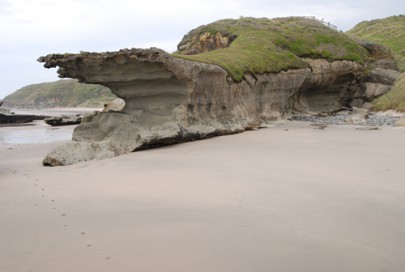Coastal turfs
In this section
-
Coastal
- Active sand dunes
- Basic coastal cliffs
- Calcareous coastal cliffs
- Coastal cliffs on acidic rocks
- Coastal cliffs on quartzose rocks
- Coastal rock stacks
- Coastal turfs
- Dune deflation hollows
- Shell barrier beaches ('Chenier plains')
- Shingle beaches
- Stable sand dunes
- Stony beach ridges
- Ultrabasic sea cliffs

Coastal turf at Sandhill Creek, Te Taitapu coast of west Nelson (Geoff Rogers)
Coastal turfs are communities of tightly interlaced, ground-hugging, short-statured herbs, grasses, and sedges occupying hard-rock landforms on the most exposed headlands subjected to persistent salt-laden onshore winds and occasional high water. They can overlie a considerable depth of peat. Originally sandwiched between the shoreline and inland coastal scrub and forest, the clearance of the bordering woody communities has enabled their expansion inland.
Notable flora and fauna
Rare plants include the nationally critical Crassula peduncularis and Gentianella scopulorum, nationally endangered Myosotis brevis, nationally vulnerable Carmichaelia juncea, Crassula manaia, coastal cress (Lepidium flexicaule, and Mazus novaezeelandiae subsp. impolitus f. impolitus, declining Lepidium tenuicaule, Myosotis pygmaea var. pygmaea, Ranunculus recens, Selliera rotundifolia, and Tetrachondra hamiltonii, naturally uncommon Acaena microphylla var. pauciglochidiata, Anisotome lyallii, Atriplex buchananii, Crassula helmsii, Euphrasia repens, Leptinella calcarea, Leptinella dispersa subsp. dispersa, Leptinella traillii subsp. pulchella, Mazus arenarius, Myosotis rakiura, Poranthera microphylla, Puccinellia walkeri and Wahlenbergia congesta subsp. congesta, and relict Sonchus kirkii.
Rare invertebrates include the pimelea looper moth (Notoreas perornata).
Threat status
Critically endangered (Holdaway et al. 2012)
Threats
Coastal turfs are subject to invasion by exotic species (e.g. creeping bent (Agrostis stolonifera), mouse ear chickweed (Cerastium fontanum), Yorkshire fog (Holcus lanatus), cat’s ear (Hypochaeris radicata), buck-horn’s plantain (Plantago coronopus), procumbent pearlwort (Sagina procumbens), and several clovers and trefoils (Trifolium and Lotus spp.)). Exotic species are most problematic in ecotones with other communities, as exotic species typically do not become dominant in the most saline conditions. Grazing by ungulates (cattle, sheep, and deer) and browsing by hares can be damaging as can heavy trampling, particularly on wet turfs. However, limited grazing may be beneficial by minimising impacts of exotic weeds and helping turfs retain their dominantly herbaceous character. In the past, this character may have been maintained by birds and marine mammals, whose populations are now substantially reduced. Accessible areas are susceptible to human impacts, e.g. vehicle damage, trampling, and subsequent erosion.
Where do they occur?
Coastal turfs occur in eight mainland New Zealand regions along the western and southern coasts of North and South Islands; the North and South Taranaki Bights, the eastern Wairarapa coast, the Te Taitapu (Whanganui Inlet) coast of west Nelson, Westland, Fiordland, Southland, Otago and the Marlborough Sounds. Coastal turfs also occur on New Zealand’s inshore and off-shore islands, the latter including Stewart (Rakiura) Island, the Chatham Islands, and the subantarctic islands. Across North and South Islands their total extent is likely less than 40 ha, making them an exceptionally rare ecosystem.
Further reading
Lee B 2008. Natural turfs of diverse tiny plants. Open SpaceMagazine No. 74, November.
Patrick B 1993. Conservation of key sites for Southern coastal moths. Part 2. Shag River Mouth South Cliffs. Weta 16(1): 5-7.
Rogers G 1999. Coastal turfs of mainland New Zealand: their composition, environmental character, and conservation needs. Science for Conservation 107. Wellington, Department of Conservation. 57p.
Rogers GM, Wiser SK. 2010. Environment, composition, and conservation of coastal turfs of mainland New Zealand. New Zealand Journal of Botany 48: 1-14.


